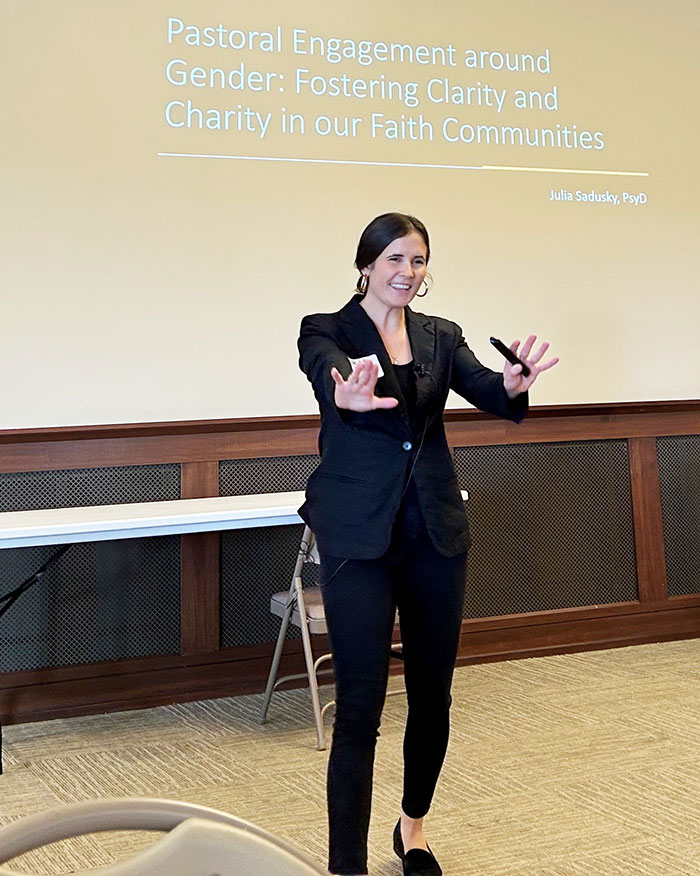
Dr. Julia Sadusky talks to clergy, parish and school leaders at St. Patrick Parish in Iowa City Nov. 6 about accompanying sexual and gender minorities.
By Barb Arland-Fye
The Catholic Messenger
IOWA City — One month after the Diocese of Davenport published its “Guidelines for Pastoral Accompaniment of Gender and Sexual Minorities,” clergy, parish and school leaders listened as two presenters well versed on the sensitive issue shared their insights.
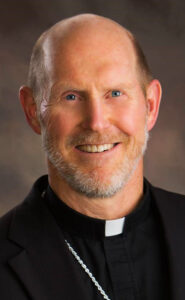
The presentations served as the centerpiece of the Fall Clergy Overnighter, held Nov. 6-7 at St. Patrick Church and The Graduate Hotel. Among the attendees was Archbishop Thomas Zinkula, whose leadership as Bishop of the Davenport Diocese led to publication of the diocesan guidelines.
His committee on gender, which drafted the guidelines, chose speakers David Palmieri and Dr. Julia Sadusky to help their audience better understand the topic and to equip the leaders with practical strategies to accompany the individuals and families they serve.
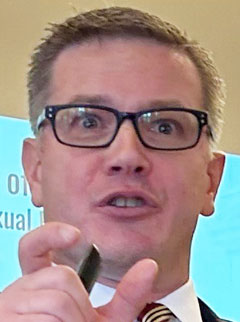
Palmieri is an award-winning Catholic educator who founded a global network of educators committed to discerning the art of accompaniment to sexual and gender minority students in Catholic secondary schools. Dr. Sadusky is an author, speaker and licensed psychologist, whose latest book, “Start Talking to Your Kids about Sex: A Practical Guide for Catholics,” received its imprimatur from Archbishop Samuel J. Aquila of the Denver Archdiocese.
Both speakers framed their talks within Church teaching and emphasized a pastoral approach that models Jesus’ encounters with people on the margins, including the parables Jesus told to demonstrate how to engage with individuals who are suffering. The goal is “to seek understanding, not to undermine the deposit of faith,” Palmieri said.
Entering the conversation
Palmieri described accompaniment of sexual and gender minorities as “learning how to navigate the narrow ridge of the in-between.” He cautioned, “There is no perfect language with which to enter this conversation.” However, entering the conversation is essential. He cited the 1986 Vatican document, “Pastoral Care of Homosexual Persons,” which identified the fundamental identity of every person as a child of God.
The term “sexual and gender minority” comes from the National Institutes of Health and the Center for Disease Control and Prevention (CDC), Palmieri said. It is “an umbrella term that encompasses lesbian, gay, bisexual, and transgender (LGBT) populations as well as those whose sexual orientation, gender identity/expressions or reproductive development varies from traditional, societal, cultural or physiological norms” (NIH). Approximately 7.1% of all adults identify as LGBT, according to a Pew Research study conducted in 2022. That percentage rises to 17% for adults ages 18-29.
CDC data shows that the attempted suicide rate is two to four times higher for students who identify as LGBT, Palmieri said. He showed slides in his PowerPoint presentation of insensitive phrases and words that these youths have heard from their peers and educators, including religious leaders. “Our Church can do better in learning how to have this conversation out here in the open in a way that doesn’t wound these students.”

David Palmieri speaks at St. Patrick Parish in Iowa City Nov. 6.
Palmieri said he teaches 100 boys in a Catholic school of 1,000 boys and has done so for more than 25 years. “That’s thousands of students, most of whom are just average adolescent kids who will never struggle with their sexual or gender identity,” he said. “We’re talking about a population that is numerically small … but in the spirit of Jesus Christ and the parable of the lost sheep, even the one deserves full attention because they exist like all of us in the one body of Christ.”
Throughout his presentation, Palmieri referenced sections of the Davenport Diocese’s guidelines, which emphasize a pastoral approach to accompaniment and listening with the ears of the heart. “Your document is a response to what you have heard in the Diocese of Davenport. The document is responding to a need for a pastoral response.”
The document also appears to emphasize the principle of subsidiarity, Palmieri said, with decision making taking place at the local level, in consultation with the diocese. “Listen to the stories, be creative. You still have the right to say ‘no’” to requests that do not align with Church teaching but not without offering the possibility of alternative solutions.
Palmieri identified the steps that “lead us forward,” which he excerpted from the diocesan guidelines:
- Catholic values and traditions (“We have to hold firm to our Catholic values and traditions.”).
- Eucharistic community (“We sincerely believe it is the Eucharist that is the source and summit of all that we do here, together.”).
- Gospel message of Jesus Christ (“Love God and neighbor; go make disciples.”).
- Build learning communities for families and schools (specifically, within the context of Catholic schools, where “we teach the whole child, learning faith and service, mind body and spirit, helping them to discern who God is calling them to be, with their unique gifts and talents so that we might prepare the next generation of leaders and Christian stewards”).
Three lenses
Dr. Sadusky, who works with individuals, families, couples and particularly youths, has extensive experience examining the intersection of sexuality, gender and theology. She observes that language becomes a weapon. “We miss each other in language all the time,” she told the diocesan leaders. “We misconstrue what people say.”
She explained the difference between sexual desire and/or orientation labels and gender identity labels. Sexual attraction refers to a person’s affection for another person in a romantic way while gender identification refers to how masculine or feminine someone feels in the world.
Citing her colleague Dr. Mark Yarhouse, she said people approach the gender conversation from three different frameworks that function as lenses — the integrity lens, disability lens and diversity lens.
- The integrity lens tends to focus on “how gender-related distress confuses the sacredness of maleness and femaleness. Specific resolutions or ways of managing these experiences are violations of that integrity.”
- The disability lens identifies “gender distress/disconnect as uncommon variations that occur in nature…. Sometimes they are likened to a disability, a nonmoral reality to be addressed with compassion.”
- The diversity lens highlights “gender disconnect experiences as reflecting a sense of identity and culture to be celebrated as expressions of diversity.” This lens asserts, “sex distinctions are social constructions and norms of sex and gender are oppressive.”
Cultural ambassadors
Dr. Sadusky is “convinced that our Catholic faith and Christ and the Holy Spirit have taken the best of those lenses and integrated them into an authentic Catholic approach.” This approach encompasses the Church’s high value of the body and body-soul unity, compassionate accompaniment and support for people with enduring challenges, and thinking about the diverse ways people reflect God and approach him in unique experiences. This approach offers “a balanced foundation for Catholics to engage from.”
Society, including the Catholic community, has so many models of how to be cultural warriors (on either side of the political spectrum) and cultural capitulators (don’t speak up for fear of offending someone). “How can we help people to become cultural ambassadors?” she asked. That is a helpful model for Catholic formation, she believes.
The psychologist, youth and ministry educator said she looks for ways to help young people, Catholic adults and parents to find areas of agreement with cultural narratives and voices. As Catholics, to honor the point of concern of another person “is a way of being an ambassador, being part of the community and shaping it … being a shaper of culture.”
Audience response
Archbishop Thomas Zinkula: “I had high expectations for their presentations and they exceeded them,” Archbishop Zinkula said. “After years of study, experience and reflection in regards to this topic, they have an excellent grasp of it. Also, they grounded their remarks in Scripture and the teaching of the Church. Finally, they have opened their minds and hearts to allow the Holy Spirit to bring about a conversion in how they view, engage and discuss sexual and gender minorities.”
“I was intrigued by Dr. Sadusky’s discussion on integrating three lens related to gender: integrity lens, disability lens, and diversity lens,” Archbishop Zinkula said. “I also found helpful her distinction between cultural warriors, cultural capitulators, and cultural ambassadors.”
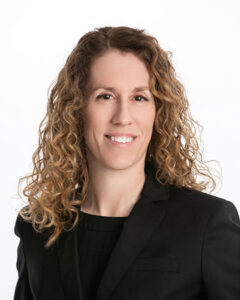
Angela Olson: “As Catholics and as Catholic leaders, we need to be prepared to have conversations on this topic. We need to be able to love and honor the dignity of every person while understanding and staying true to Catholic teaching,” said Olson, head of school for Regina Catholic Education Center in Iowa City. “I didn’t expect to find a cut-and-dry answer. I expect us to continue to wrestle with it because it’s hard and it’s worth the effort to learn how to treat people with dignity and love.”
Olson identified two insights she gained. “As Catholic leaders, we must ensure every person feels loved. The statistics shared on mental health are concerning and emphasize the importance that what we say and how we treat people must be intentional. In a school environment, we must find a way to balance supporting students and adhering to Catholic teaching. I appreciated ideas such as using the saints as examples and thinking critically and creatively when it comes to school rules and procedures.”
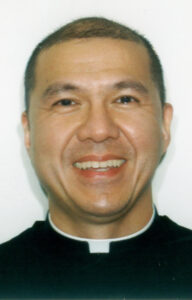
Father Joseph Sia: “The approach was general, which I believe was their goal, because they themselves said they didn’t want to tell us what to do; rather, they were sharing overarching ideas and giving examples from their own experiences,” said Father Sia, pastor of parishes in Ottumwa and Bloomfield. “There are still many themes that can be discussed here; for example, medical ethics, moral theology, Christian anthropology, pedagogical or catechetical skills, etc.,” he said. The “presenters held up a mirror to us as a diocese to allow us to look further into ourselves and our thoughts on these issues.”
Father Sia said he agrees with the presenters “in that we are to meet people where they are at, be not afraid to use the actual terms/words/language that they are using, acknowledge and appreciate their honesty and trust in sharing with us their innermost thoughts and feelings. (These principles are actually useful in many other pastoral situations and not just with persons questioning their gender identity.)”
“This is the first part of the process, but pastoral care goes beyond this,” Father Sia said. “The next stage is where the potential for a successful response lies, and my hope is that as a diocese, we go into this next stage. I suggest further discussion within the same cohort (i.e. school and parish faith formation leaders, clergy, chancery directors and staff) on the nuances of these issues and how they relate to the realities on the ground.”

Father Chris Weber: “I wasn’t sure what to expect. I was hoping for an opportunity to really dig into the question of what it means to accompany a person who is struggling with gender or sexuality issues, and what the ultimate goal of that accompaniment should be,” said Father Chris Weber, pastor of Ss. Mary & Mathias Parish in Muscatine.
“I walked away with some good tools to use in that initial encounter with a person who is struggling with questions around their gender or their sexuality, but unfortunately we missed the opportunity to have a conversation about the true goal of accompaniment in these kinds of situations. That seems to me to be the most important piece of the conversation, and we haven’t had a chance to enter into that discussion, yet.” Father Weber said he was “struck by the need to be precise in our language and the terms we use, and the strong desire of our teachers, principals, school chaplains, and lay ministers, to have a chance to be a part of this conversation.”
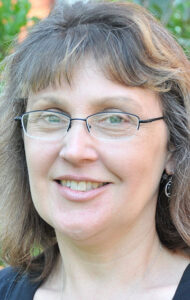
Marianne Agnoli: The diocesan Marriage and Family Life coordinator, who serves as chair of the gender committee, said Palmieri and Dr. Sadusky equipped participants with some practical strategies for pastoral accompaniment. There is still much to learn in the area of pastoral ministry and the importance of respectful dialogue in continuing these conversations, Agnoli said.
She learned that “it is possible to navigate the ‘narrow ridge’ of addressing the real pastoral needs of sexual and gender minorities and their families, while remaining true to the teachings of our Catholic faith.”
The timeliness and relevance of these conversations, she said, is evident in the release of a document from the Vatican’s Dicastery for the Doctrine of the Faith regarding “the baptism of trans individuals and the ability of both gender and sexual minorities to serve as godparents or witness to a wedding.”











